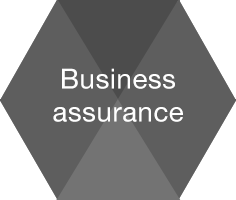Business Assurance
In essence business assurance consists of the same ingredients as assurance for individuals – life, endowments, retirement provision etc. The differences lie in the tax aspect and special legal arrangements. The latter can be used to solve some of the problems which typically would be the fall of many people in the commercial field.
The reason for separating it from ordinary assurance is because it tends to get complicated, so it needs expert advice as well as special implementation.
By its very nature as an invisible and intangible product it is unfortunate that as with the run of the mill company documentation, it is mostly put on the backburner. This can have devastating effects on the partners in a company in some cases, and unnecessary tax burdens in others.
The following is a very abbreviated description of some of the more common types of business assurance products and ideas. We would strongly recommend that business owners spend time talking through this very important aspect of their company’s life.
1. BUY & SELL AGREEMENTS
The principle
Ideal for Partnerships, Close Corporations, and Pty’s. The members (shareholders etc) effect life insurance policies on the life of each co-member (preferably with disability cover). They contribute to the premiums, in proportion to their share of the business, and as set out in the Buy & Sell Agreement provided by us.
The agreement between the members provides for
- The members sell their equity to the survivor(s) on death or disability.
- The survivors purchase the deceased or disabled member’s equity.
- A purchase price or a method of calculating it.
- The insurance policy taken out by the surviving members will fund the purchase price.
This is a very logical method of ensuring some form of compensation for the deceased’s family. It also safeguards the other partners to carry on with the business, without interference from the deceased family and is much cheaper than trying to get a loan when a sudden death occurs. There are also no arguments about the price if the transaction was structured correctly.
The premium pattern chosen may allow for escalation of the risk benefits annually to keep pace with the growth in the members’ equity and the cost of the cover is split pro-rata amongst the other members – thus ensuring fairness.
When the shareholders retire from the business they can take cession of the policy benefits (without rendering the policy ‘second- hand’) thus retaining valuable risk cover, as they grow older & less insurable.
Provided the life assured is never the proposer or premium payer of the policy on his/her own life, the proceeds are exempt from estate duty, unlike ordinary life assurance. Furthermore, the deceased or disabled member’s family receive a substantial cash inheritance free of income tax & CGT.
Shareholders’ loan accounts are usually included in the sale and if a shareholder leaves the business he or she may take out the equivalent cover in a new policy without medical underwriting or HIV tests.
2. THE KEY PERSON
The principle
It will be of value to any employer that will suffer financial loss or disruption due to the termination of service of an employee and therefore:
- The company effects pure risk insurance with death cover (and preferably disability cover) on the life of the key person equal to the value of the key person to the business.
- The company pays the premiums and may deduct them from taxable income.
- The employer may decide to protect its profits only in the event of death or disability, or it may decide to bind the key person through a service contract in terms whereby a gratuity is payable to the key person.
The Employer’s Benefits
- The proceeds are paid out to the employer to use at his own discretion, or as contractually stipulated.
- The employer protects his or her profits in the event of the death / disability of a key person.
- May be used to compensate the employer for loss of income as a result of the death or disablement of the key employee and also for recruiting and training suitable replacements.
The Employee’s Benefits
- Premiums may be deducted from the taxable income of the company up to a maximum of 10% of the employee’s remuneration.
- The employee may negotiate that some of the benefits can be payable to his family in event of death or disability, or may negotiate that a certain investment portion be included in the premium for his benefit.
3. PREFERRED COMPENSATION
Applies to an employer who wishes to improve an employee’s package in a tax-efficient manner without forcing the employee to stay on until retirement age.
The principle
- The employer gives the employee an increase, on condition that the after-tax remainder of the increase is invested in an endowment or investment plan, owned by the employee.
- In return the employee agrees to remain in service for a minimum of 5 years.
- The policy is entered into for a minimum period of 5 years.
- The policy is lodged with the employer for safekeeping.
- The increase in salary (i.e. the premium payment) is tax deductible for the company.
- At the end of 5 years the policy generates a tax-exempt lump sum that can be distributed according to the agreement between employer and employee. This could involve all, or a portion of the money being paid immediately and the balance paid in increments.
- All the above stipulations must be contained in an agreement between the employer and employee in order to validate the deductibility of premiums and protect both parties.
The Employer's Benefits
- Will foster loyalty and retention of skills. Contributions are tax deductible for the company.
The Employee's Benefits
- Will provide a tax-exempt benefit long before retirement.
- Does not negatively affect any benefit or tax-deduction the employee may receive under other pension or retirement plans- in fact those may be enhanced due to the increased salary.
- Good growth – fund tax is only 28% compared to maximum marginal rate of 40%.
4. CONTINGENT LIABILITY COVER
The principle
Applies to any director, shareholder or member of a business who has signed personal surety or provided some form of personal guarantee for the obligations of the business – and who hasn’t?
- The business takes out a pure risk insurance policy with death cover (& disability if required) on the life of the owner for an equivalent amount to the value of the debt guaranteed by the surety.
- The business (e.g. the company) pays the premiums and may deduct them from taxable income.
- A contract is entered into between the business & the surety in terms of which the business agrees to, inter alia, secure the release of the surety/guarantor from his or her obligations to the creditor by utilising the policy proceeds to settle the debt.
- The policy is ceded as collateral security to the surety, to ensure that the business complies with its obligations in the aforesaid contract.
Benefits for the business
- Makes it easier to find someone willing to stand surety.
- Makes business safer – reduces the risk of a cash flow crisis.
- The business remains the owner of the policy.
5. DISABILITY INCOME AND OVERHEAD EXPENSES PROTECTOR
The principle
Compensates the assured for loss of income derived from his or her regular occupation or for the overhead expenses of his or her business, due to injury or illness.
Deductibility of premiums
The premiums paid under Income Protector are regarded as expenditure to secure an income and are therefore a deduction from taxable income. Any benefit received is regarded as taxable income.
Waiting Period
The assured may choose – subject to the assurers norms – his or her own waiting period from 1,3,6,12, or 24 months, or even 7 days, but only 1 & 3 months for temporary income protector & overhead expenses protector. However a 7 day waiting period can also be chosen for temporary income protectors.
Limits
You can expect up to 100% of your average monthly income for Temporary Disability and 75% for the Disability Income Protector but not more than R 150 000.00 per month.
6. PROVIDENT FUNDS
The principle
Provident Funds are retirement savings vehicles for employees. It is an umbrella fund to which employers can become affiliated and for each employee (member) on the fund, an endowment policy is taken out.
The Employer's Benefits
- The employer offers his employees a more competitive or flexible remuneration package.
- The contributions paid by the employer are tax-deductible, up to a maximum of 20% of the employees’ remuneration.
- The employer determines the contribution rate, within prescribed bands.
The Employee's Benefits
- The premiums are utilised for investment only.
- No income tax due on contributions, and tax favourable treatment of proceeds on death, disability or retirement arise.
- Fund is protected from the insolvency of employer and employee.
- Can buy-back years of service.
- On resignation, the new affiliated employer can continue paying the premiums.





